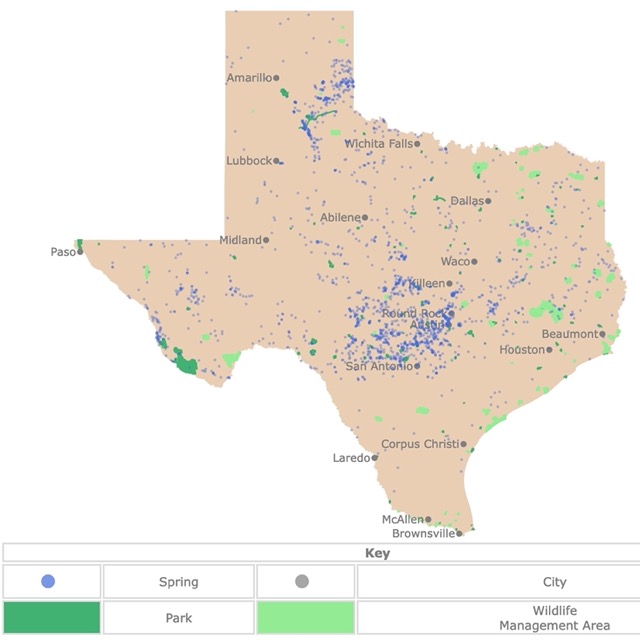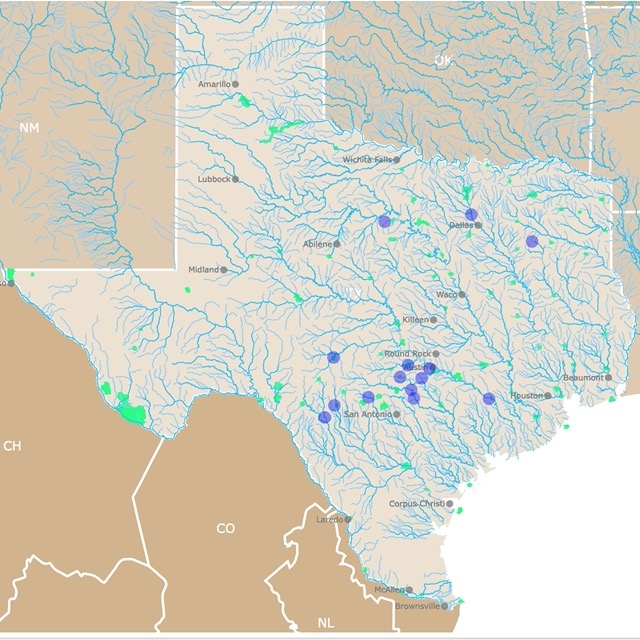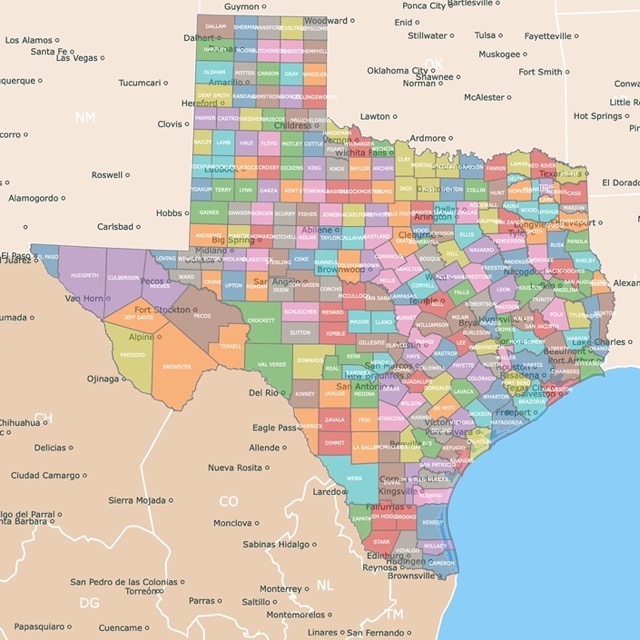Map of Texas
This interactive map of rivers, lakes, cities, and roads of Texas. For Rivers, Lakes, Interstates, and Roads names, hover over the map. For more detail, zoom in, or scroll down.
| Key | |||||
|---|---|---|---|---|---|
| ◯ | City | ― | Road | Lake or River | |
| Texas | USA | Mexico | |||
Texas Geography
Texas, known as the Lone Star State, is a state located in the southern region of the United States.

It shares borders with Oklahoma to the north, Arkansas to the northeast, Louisiana to the east, New Mexico to the west, and the Mexican states of Chihuahua, Coahuila, Nuevo León, and Tamaulipas to the southwest. The Gulf of Mexico lies to the southeast of Texas.
Texas is the second-largest state in the U.S. by both area and population.
The capital city of Texas is Austin, and other major cities include Houston, Dallas, San Antonio, and Fort Worth.
Texas is crisscrossed by numerous rivers, including the Rio Grande, which forms part of the southern border with Mexico, the Colorado River, the Brazos River, and others, which play crucial roles in the state's water supply, irrigation, and transportation.
Texas experiences a variety of climates due to its size. The eastern part generally has a humid subtropical climate with hot summers, while the western areas are more arid with hot summers and mild winters.
The northern parts can experience colder temperatures during the winter.
If you want to learn about Texas history and geography Amazon has Mapping Texas: A Cartographic Journey, 1561–1860. This book illustrates how familiar cities dot this vast expanse of land, railroads trace the outline of rivers and mountain ranges, and ports anchor the curve of the Gulf of Mexico. Texas’ rich history comes to life one map at a time.
Texas Cities
Texas is home to numerous cities, each with its own characteristics and charm.
Houston
The largest city in Texas and the fourth-largest city in the United States.

Houston is known for its diverse population, thriving energy industry, and cultural attractions, including museums, theaters, and sports teams.
The city is also known as Bayou City. This is one of the reasons why this website is called DATABAYOU!
As a former Houston resident, I can say the city has it all. You can go to water parks, Johnson Space Center, and even a drilling rig museum.
The Museum of Modern Arts is free on Thursdays, and Galveston is close enough to spend the day at the beach!
Dallas
A major economic and cultural hub in North Texas. Dallas is known for its modern architecture, arts district, and professional sports teams.
Austin
The state capital of Texas is a vibrant city, with a unique and eclectic culture.
Austin is renowned for its live music scene, festivals, technology companies, and outdoor activities.
If you are interested in this dynamic city Amazon has Shadows of a Sunbelt City: The Environment, Racism, and the Knowledge Economy in Austin (Geographies of Justice and Social Transformation Ser.) This book is particularly attentive to the role of the University of Texas (often working with federal, municipal, and private-sector partners), and the book will join a growing critical literature about how universities shape urban environments.
San Antonio

Famous for its historic sites, particularly the Alamo, a key landmark in Texas history.
San Antonio also boasts the beautiful River Walk, a network of pedestrian pathways along the San Antonio River with plenty of restaurants and shops to visit.
El Paso
Situated in West Texas, El Paso is known for its diverse culture.
Corpus Christi
A coastal city with beautiful beaches and a strong connection to the Gulf of Mexico.
It's a popular destination for water sports and outdoor enthusiasts.
Amarillo
Located in the Texas Panhandle, Amarillo is famous for the Cadillac Ranch art installation and its proximity to Palo Duro Canyon, the second-largest canyon in the United States.
Unsure of what you want to see first in Texas? Expedia can help you decide:
Texas Road Infrastructure
The Texas Department of Transportation (TxDOT) manages and maintains the state's road infrastructure.

Texas is crisscrossed by several major interstate highways, including I-10 (East-West), I-20 (East-West), I-35 (North-South), I-45 (North-South), I-30 (East-West), I-40 (East-West, in the northern panhandle), and I-37 (North-South).
TxDOT maintains over 79,000 miles of farm-to-market, ranch-to-market, state, U.S., and interstate highways.That's more roadway than any other state.
This includes highways, freeways, farm-to-market roads, county roads, and city streets.
Texas has an extensive network of toll roads, especially in and around major metropolitan areas, which allows for faster travel but requires payment of toll fees.
Texas has over 60 miles of toll roads. Texas opened its first toll highway in 1957, connecting Dallas and Fort Worth. Source: TXDOT.
Major cities in Texas, such as Houston, Dallas, Austin, and San Antonio, often face traffic congestion during peak hours due to their large populations and economic activities.
Texas is well-known for its rural areas and agriculture, and the state maintains a significant number of Farm-to-Market roads that connect rural communities and agricultural areas to larger towns and cities.
Due to the state's large size, road trips in Texas can be quite long.
For example, driving from the easternmost city of Beaumont to the westernmost city of El Paso can take around 11-12 hours, covering approximately 800 miles (1,287 kilometers).
Texas Economy
Texas has one of the largest and most diverse economies in the United States. Its economic strength is driven by several key industries and factors.
Oil and Gas
Texas is known for its vast reserves of oil and natural gas.
The state has a long history of oil production and remains a major player in the energy sector.
Cities like Houston are significant hubs for the oil and gas industry, hosting headquarters of many energy companies.
Technology

Texas has emerged as a major technology and innovation center, particularly in cities like Austin, which is often referred to as "Silicon Hills."
The state attracts tech startups, software companies, and research institutions, fostering a thriving tech ecosystem.
Manufacturing
Texas is a leader in manufacturing, producing a wide range of goods, including electronics, machinery, chemicals, and automobiles.
The state's central location and extensive transportation infrastructure make it attractive to manufacturing companies.
Agriculture
Texas has a robust agricultural sector, producing crops such as cotton, corn, wheat, and sorghum. The state is also a leading producer of livestock, particularly cattle.
Aerospace and Defense
Texas is home to several aerospace and defense companies, including NASA's Johnson Space Center in Houston.

The state plays a significant role in the aerospace industry and defense-related research and development.
International Trade
Texas benefits from its proximity to Mexico and the Gulf of Mexico, making it a vital gateway for international trade.
Ports like Houston and Corpus Christi handle a substantial portion of the country's foreign trade.
Tourism
Texas attracts millions of tourists each year with its diverse range of attractions, including historical sites, cultural events, national parks, and vibrant cities.
Major tourist destinations include San Antonio's River Walk, the Alamo, the Texas State Capitol in Austin, and various music and cultural festivals.
In Texas, even gas and travel stations turn into destinations like Buc-ee's.
Healthcare
The healthcare sector in Texas is significant, with numerous hospitals, research centers, and medical facilities across the state. Source: Texas.gov.
Texas Regions
Texas has a diverse geography that includes various landscapes, climate zones, and natural features. The state's vastness contributes to this diversity.
Gulf Coast

The eastern part of Texas borders the Gulf of Mexico, providing the state with a long coastline.
This area is characterized by coastal plains, marshes, and barrier islands.
Piney Woods
Located in the eastern part of the state, this region is known for its dense pine forests, rolling hills, and abundant rainfall.
Prairies and Lakes
Stretching from the east to central Texas, this region features grassy prairies, fertile agricultural lands, and numerous lakes and reservoirs.
Hill Country
The central part of Texas is characterized by the Hill Country, an area of rolling hills, limestone cliffs, and clear-flowing rivers.
This region is famous for its scenic beauty and is a popular tourist destination.
Panhandle Plains
Located in the northwestern part of the state, this area is characterized by flat, high plains and a semi-arid climate.
It is known for its cattle ranching and agriculture.
West Texas
This region includes the vast Chihuahuan Desert, which covers much of western Texas.
It is arid and features desert landscapes, canyons, and plateaus.
Resources for Texas Map
The shapefiles for cities, rivers, lakes, and roads came from Natural Earth.
This information will also improve with your suggestions. To receive updates on this and more nature maps, join my email list!!!!!!!
Made by Luz K. Molina with D3.js.








